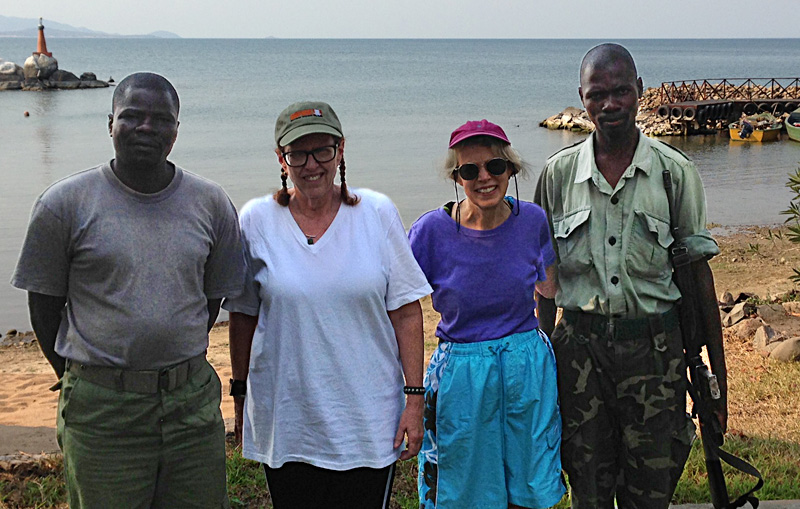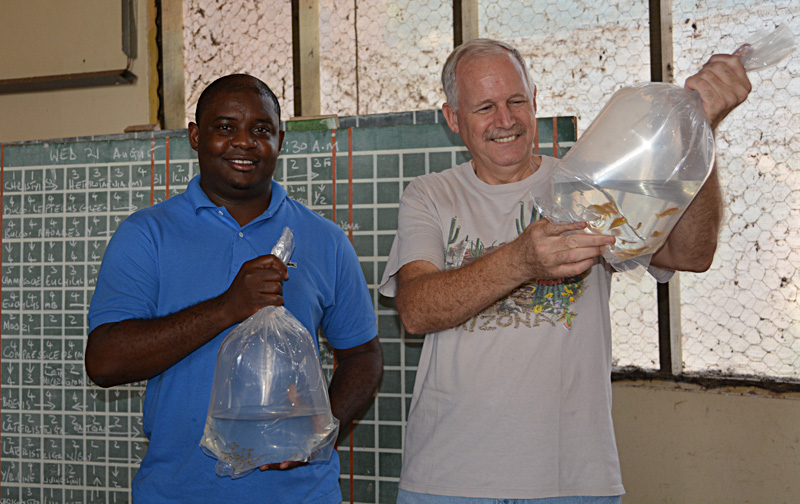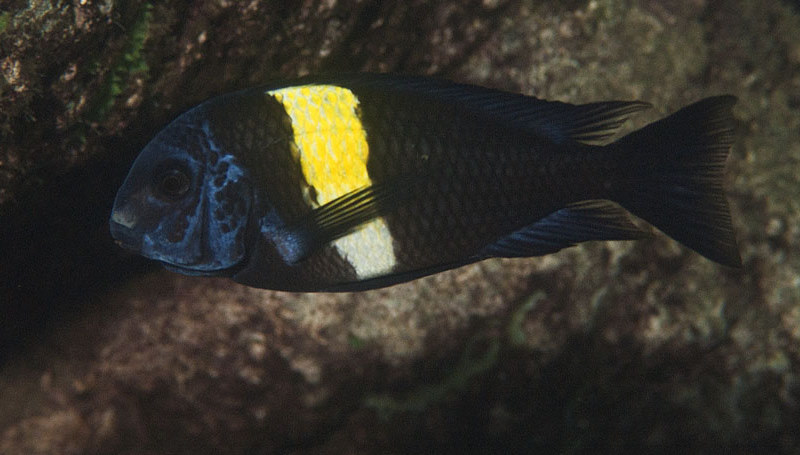Dear Malawi cichlid friend, There are so many items I would like to tell you that I have split them up in sections, i.e. Park guards, ANDs, breeding of endangered species, and news from Lake Tanganyika. Park guards Together with Claudia Dickinson (C.A.R.E.S.) and Pam Chin (Babes In The Cichlid Hobby super fundraiser) I met with Dimitri Giannakis (owner of the Blue Zebra Island Lodge) and the new managers of the Nankoma Island lodge, Estelle Beck and Matt Leger. We were also joined by two of the park guards, Leonard Mtonya and Blessings Kasambala, who informed us about their activities in the park and in the villages around it. The captain of the group, Thomas Mpulanya, could not join. We all know that education is the key to long term protection of the biodiversity of Lake Malawi and I was very encouraged by the efforts of the guards towards that goal. They regularly visit schools in the area and tell the young students about the natural world of Malawi. They donít have a lot of means, such as projectors or posters to illustrate their message, but I hope we can help them in that respect. The other important task they perform is the controlling of the no-fishing zone around the Maleri islands. Previously I understood that two to four times a month they would cruise around the islands and arrest any fisherman in violation, but each of their missions lasts about a week during which they camp on each of the islands alternatively and monitor illegal activity day and night. Illegal fishing is a lot less than two years ago when they started but it is still not zero. Dimitri has supported the guards since they started with food, fuel, and even bicycles so that they can get around to the various villages. In order to cut down on the largest expense, the 80-100 L of fuel every month, we are still in the process of obtaining a suitable boat for the diesel engine the funds obtained last year. |

|
Anti-Netting Devices When Leon du Plessis left the lodge on the island he also took all the equipment related to diving, so new equipment had to be ordered and should have arrived by now. Matt and Estelle are both very much engaged in continuing to place (and replace) the ANDs. I hope soon to have some photographic evidence of that activity. Five to six years ago Alan Pitman replanted some Vallisneria in the only sandy bay on the islands, Bata Bay on Maleri Island, and prevented the pulling of beach seines by placing large metal objects (thrasher baskets) on the sand. Matt and I inspected that area and found that at some places the Vallisneria took hold and had grown into 1-2 meter-wide patches that looked very promising in re-establishing the field of water plants that was still there when I dived at Maleri Island in the 1980s. The Vallisneria are very important in protecting the fry and juveniles of most utaka as the females release their offspring in schools in the very shallow water. Among the water plants the fry find food and shelter and in a healthy situation such plant fields teem with thousands and thousands of baby fish. I believe that the re-establishment of proper nursery grounds for the utaka will drastically improve the catch per effort rate of the fishermen outside the 100 meter boundary line. Matt is going to ramp up efforts in growing and spreading the plants in Bata Bay now we saw that it was successful. |

|
Breeding of endangered cichlids Some mixed news on this front. Although David Nkhwazi managed to breed several hundred P. saulosi, almost all were wiped out by a freak cold spell in May when he lost about 75% of his entire stock of fish. When we arrived mid September there were 32 juveniles available for restocking and a few recent broods that consisted of about 100 fry. We decided to go through with our planned release of these juveniles at Taiwanee Reef. Before release, six divers swam a 15-minute survey round in which each counted how many P. saulosi they saw. The average of that was about 40 individuals (when I found this fish in 1989 there were large schools of hundreds of individuals covering the large boulders of the reef). We then released the 32 juveniles at one spot and the hundred fry at another. There was no apparent trauma on the part of the fish due to the fact that they were taken immediately to a depth of 9-10 meters and the 32 juveniles grouped together in a small school and were later joined by a small resident female. The fate of the fry was not as good; they were too small actually and even herbivorous mbuna started to hunt them. It was a trial and for the future we shall not use such small fish for release. David will now monitor the fry more closely when the cold season approaches and I hope we will have several hundred P. saulosi to be released next year. |

|
The breeding efforts of Melanochromis chipokae were much less successful. During the cold spell they were relocated into the fish house and due to oversight were shipped to a client in Europe. It is hoped that their story doesnít end there and that David manages to find new breeding material. He will set up a very large holding vat for them as they are rather aggressive among themselves and need space to breed. Lake Tanganyika Chris and Louise Horsfall of the Lakeshore Lodge in Kipili, Tanzania, decided they want to help the local community even more (all their employees are local and they support local schools as education is key to everything) by starting to breed fish. Also in Lake Tanganyika the food fish populations are getting hammered by over-fishing and also there the fishermen are asking for help. I believe that breeding food fish would be a viable option but growing them up to consumable size would be a problem. A compromise can be reached whereby local food fish species are bred in ponds, the fry are raised to juveniles say 6-9 months old (beyond their most vulnerable stage) and then released back into the lake. (A similar scenario is also going to be pursued in Senga Bay, Lake Malawi, by Samantha Ludick of Cool Runnings Lodge.) Apart from the food fish Chris and Louise also want to do something about the species that have been over-collected by the ornamental fish trade and the most vulnerable species at the moment is Tropheus duboisi, in particular the so-called Maswa Duboisi. Last year three experienced divers had problems to find a single adult individual at Maswa and at Halembe, the two places that are fished by collectors. I suggested to Chris to breed this species and restock them at the place from where the breeders were collected. To set up the breeding system they will first try to breed a species that has not yet been overfished but that may be vulnerable in the near future, i.e. T. moorii Tanzania Murago. If everything works they may even sell the offspring of the T. moorii and/or exchange them for breeders of the Maswa Duboisi. This is still in the planning phase but weíll be ready to support them if a need arises. |

|
Fund support In the near future the main item on our agenda is to provide major funding for the guardís boat at the Maleris and to provide educational materials to the lodge and guards. Smaller items for the breeding setup in Kipili will be provided as they are needed. In discussion is also to incorporate news and programs of the Stuart M. Grant Cichlid Conservation Fund on the CARES website for which Claudia and I will work out the details. Iím very happy to tell you that I see light at the end of the tunnel and that the future of Malawi and Tanganyika cichlids looks bright again.Thank you all for your continued support. Enjoy your Malawi cichlids! |
